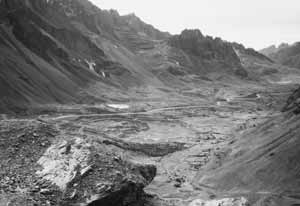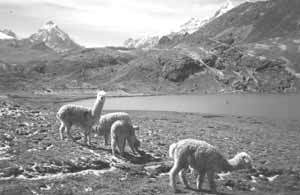|
The
Andean Corridor: Intervention Strategies and Policies for Risk Reduction
and Sustainable Development
Nelly Gray de Cerdán(1)
 MERCOSUR,
the economic union of the Southern Cone countries that began in 1995,1
faces among many other challenges the need to find cost-effective ways
of using Chile’s Pacific Ocean ports as a link to East Asia and the
Western ports of the North American Free Trade Agreement (NAFTA) countries.
But the geomorphologic structure of South America conspires against this
objective. MERCOSUR,
the economic union of the Southern Cone countries that began in 1995,1
faces among many other challenges the need to find cost-effective ways
of using Chile’s Pacific Ocean ports as a link to East Asia and the
Western ports of the North American Free Trade Agreement (NAFTA) countries.
But the geomorphologic structure of South America conspires against this
objective.
As the spinal column
of the continental divide, the Andes offer very few East-West passages,
increasing both the risks and the costs of trade. Other than Chile, which
lies west of the mountain rage, Southern Cone countries have historically
tended to ship their exports from the Atlantic—which was satisfactory
only when Europe and Eastern North America were their main markets. Incorporating
the Andes into the regional development process is thus a strategic political
and economic objective for ensuring the development of MERCOSUR, given
the importance of Pacific Rim markets.
With the launch of
MERCOSUR, the most accessible East-West passages became true bottlenecks,
very difficult to manage due to the rapid increase of overland shipping2
and the inability of the regional alliance to build the infrastructure
and provide the maintenance needed to counter Nature’s hostility
in the dangerous mountain passes.
The increase in land transport, without adequate services and with deficient
road networks, also increased the risks posed by natural hazards, as well
as the vulnerability of mountain residents and the safety of trade flows.
Such hazards would increase every winter, when road closures due to snow-storms
or landslides would sometimes extend over 10 days or more, with no alternative
route for the merchandise already in transit, costing the business sector
millions in losses.
At present, most East-West
MERCOSUR trade—70%—goes through what is called the Central Bi-oceanic
Corridor. Its Andean section, called the Andean Corridor or the Cristo
Redentor-Libertadores Corridor, links the north of Mendoza Province, Argentina,
with the Valparaiso region of Chile. It is the only mountain pass with
the infrastructure and services needed to handle such trade volume, and
is of strategic importance for the flow of goods and services between
the Atlantic and the Pacific.
In such circumstances,
land use management and risk management policies play a key role in reducing
marginal costs and risks and improving the safety and reliability of the
Corridor.
Land use management policies in the Andean Corridor
Improving the infrastructure
of the Andean Corridor and adopting newer and more effective technologies,
indispensable tasks for ensuring the competitiveness of the Andean trading
block, have become the joint responsibility of the governments of the
Chilean Fifth Region (Valparaiso), the Metropolitan Region of Chile, the
Argentinean federal government and Mendoza province, with a strong role
by private companies that see the Corridor as a key growth opportunity.
In this context, the
Ministry of the Environment and Public Works of Argentina, through the
Environmental Management and Urban Development Directorate of the Under-secretariat
for the Environment, agreed upon an action plan based on the following
goals:
- Improving the
interdisciplinary capacity of the institution’s human resources
to engage in land use management and preventive risk management of the
Andean Corridor.
- Building institutional
capacity in the area.
- Strengthening
a regional approach to the Andean Corridor in order to promote international
cooperation for the risk management and effective operation of the Corridor.
In parallel, the Ministry
launched an Andean Corridor Land Use and Risk Management Project. The
plan is currently under development and will cover the section between
Álvarez Condarco and Las Cuevas in Argentinean territory.
The Project includes
specific sub-projects aimed at promoting the development of the area,
reducing costs, increasing safety margins and reducing the risk of natural
disasters. The overall goal is to ensure the coordinated and efficient
management of resources to guarantee the sustainability of the Corridor
and its trade in the new international context.
The sub-project are
the following:
• Land use management
of the Potrerillos-Cacheuta-Álvarez Condarco section.
• Land use management and risk management of the Inca Bridge area.
• Land use management of Uspallata.
• Land use management and risk management of the High Mountain area.
• Support for the project to rehabilitate the Trans-Andean railroad.
As well, the government
of Mendoza has begun intensely coordinating its actions with those of
the government of the Fifth Region of Chile through bilateral protocols.
For more information,
please contact:
Nelly Gray de Cerdán
Director of the Centre for MERCOSUR
Territorial Strategies of Cuyo National University,
Mendoza, Argentina.
nelgray@spsarg.com
- MERCOSUR currently
comprises Argentina, Brazil, Bolivia, Chile, Paraguay and Uruguay.
- The Cristo Redentor-Los
Libertadores pass, which links Argentina and Chile, historically served
a region of some two million inhabitants. Alter Mercosur was established,
it became a trade route serving a block of 200 million people.
| Final Thoughts
 The
Andean Corridor experience has once again taught us the lesson that
the environmental fragility of high mountain regions in the face
of human habitation calls for the greatest creativity and control
over the environmental processes unleashed by society, particularly
when they involve highly dynamic economic activities such as the
transport of merchandise aimed at international markets. The
Andean Corridor experience has once again taught us the lesson that
the environmental fragility of high mountain regions in the face
of human habitation calls for the greatest creativity and control
over the environmental processes unleashed by society, particularly
when they involve highly dynamic economic activities such as the
transport of merchandise aimed at international markets.
The inability
to date by MERCOSUR countries to maintain and improve such a crucial
and yet hazardous trade route calls for a carefully coordinated
and integrated approach. Territorial management, understood as the
combination of land use management plans and risk management for
disaster prevention, is the right tool for developing the strategies
and policies needed to reduce risk and promote development.
Several weaknesses
must still be overcome:
- Territorial
management has not yet been fully incorporated into MERCOSUR integration
efforts. This excludes mountain trades corridors from regional
development plans. The lack of territorial management plans is,
in fact, a key institutional vulnerability of the trade block.
- Disaster
managers and professionals in the region still tend to focus on
emergency management rather than risk management, which involves
disaster prevention, mitigation and awareness-raising components.
- Local governments
are the ones best suited to promote the development of mountain
areas, but they are also the weakest from a financial, legal,
professional and technological standpoint. This must be addressed
promptly and decisively.
Finally, it
may be necessary to review the planning units that are currently
in use, and perhaps restore some concepts that have been partially
abandoned over the years. One of them is the development, planning
and management of river basins. Such an approach might be useful,
given that most of the available mountain passes that can serve
as trade corridors have been created over geological time by complex
river systems. Basin management might be the right approach to bring
together land use management and risk management. But this is a
pending issue for discussion among those interested in strategic
and policy planning.
|
|




